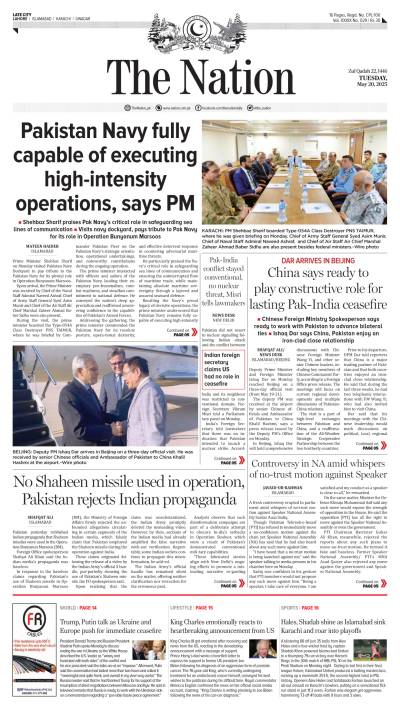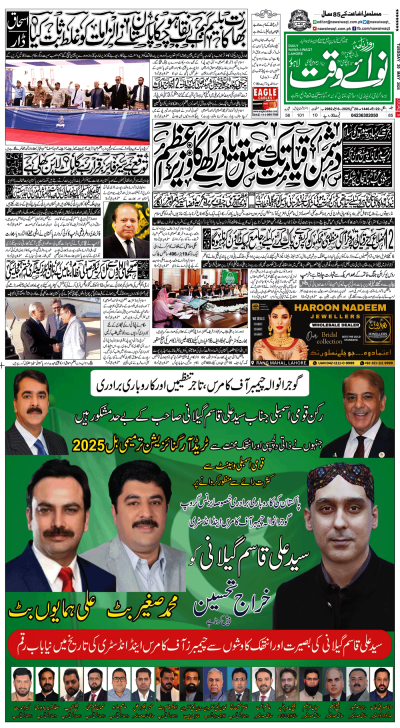Islamabad - Renowned Cardiologist Maj-Gen Dr. Azhar Mahmood Kayani (retd) is a success story with distinct professional achievements. With more than 30 years of experience, 13 professional organization memberships, and numerous prestigious appointments, including President of Pakistan Cardiac Society, Maj-Gen Dr. Kayani is widely known for establishing state-of-the-art and iconic Rawalpindi Institute of Cardiology (RIC).
In an exclusive interview with The Nation, Dr. Kiyani, who originally hails from Jhelum, spoke on wide-ranging issues including professional life, challenges, and achievements and underscored the need for efforts to reform the country’s healthcare system, especially treatment facilities for the cardiovascular diseases. He continues to inspire the medical community and the general public with his passion and deep motivation to serve humanity.
Following are excerpts of his interview:
Q: Where have you been posted to serve throughout your career?
Ans: In 1989 with MRCP qualification and completing the specialist training, I got posting in the Armed Forces Institute of Cardiology (AFIC) and established the cardiology department in Combined Military Hospital (CMH) in Multan and headed it for six years.
In 2008, I was promoted to the rank of Major-General and given the command of AFIC and National Institute of Heart Diseases (NIHD) and, along with the promotion, was also appointed as the personal physician of the President of Pakistan till 2012.
During my career, I also served on the positions of Director General (DG) Medicine in General Headquarters (GHQ) and technical adviser to the World Health Organization on cardiovascular diseases.
In September 2012, I retired from AFIC, however, before that was approached by then Punjab Chief Minister (CM) Shehbaz Sharif who offered me to take the charge of newly-built Rawalpindi Institute of Cardiology (RIC).
In 2002, I was appointed as the personal physician of the prime minister and had the honour of doing the service for six years from 2002 to 2008 with five PMs of the country.
I served as a personal physician of ex-PM Zaffarullah Khan Jamali, interim PM Chaudhry Shujaat Hussain, Shaukat Aziz, Mian Mohammad Somroo, and in 2008 worked with former PM Yousuf Raza Gillani.
Q: Generally people give you a credit for establishing state-of-the-art Rawalpindi Institute of Cardiology (RIC). What would you say?
Ans: Yes, RIC is one of the projects of my life I can feel pride. Public is the best judge to see the performance of any institution. Initially, I refused to accept the responsibility offered by the then Punjab Chief Minister Shehbaz Sharif. I asked CM that the authority of hiring and removing the employees in RIC will rest with my designation, merit will be observed in selection, there will be no political and departmental interference and I will have direct access to the CM.
I made these demands as I wanted to take complete responsibility for its success and failure and I didn’t finish my work with disappointment.
RIC became a state-of-the-art facility in the government sector where 90 percent of treatment was being done free of cost and in eight years it had the latest equipment with the same budget. RIC made collaboration with three international institutes of cardiovascular diseases in the United Kingdom and the USA and highly qualified heart specialists trained the cardiologists of RIC.
The heart emergencies, which had a 90 percent mortality rate in Pakistan, dropped to 10 percent due to this training and now RIC is self-sufficient in treating complicated heart procedures.
Q: Will you share the background of controversy about the quality and pricing of the stents used in Pakistan a few years ago?
Ans: The issue of stents cropped up after the Supreme Court (SC) got involved in it. Consequently, the SC had to form a National Interventional Cardiology Board (NICB) under my supervision which had members from all the provinces.
Heads of Punjab Institute of Cardiology (PIC), National Institute of Cardiovascular Diseases (NICVD) Karachi, Lady Reading Hospital Khyber Pakthunkhwa (KP), and Bolan Medical College from Balochistan all were its members.
The NICB, after thorough work, presented its report in SC with the recommendations that only Federal Drug Agency (FDA) USA, NICB and CE mark recommended stents could be approved by the Drugs Regulatory Authority of Pakistan (DRAP).
The NICB recommendations dropped the price of the cardiac stents also and the product being sold for Rs150,000-200,000 dropped to Rs100,000. NICB also recommended that the Chinese stents being used in Europe should only be approved to be used in the hospitals of Pakistan.
The NICB had given its recommendations on pricing and quality of stents in SC in two lists, however, the DRAP had notified only one list of stents and the other is pending for the last two years. A standard of stents was set in the report and recommended products were approved based on the scientific data, clinical trial history of the stents.
The other list is pending with the ministry of NHS and DRAP for the last two years and its approval will benefit the public. A delay in the approval of other recommended list will lead to any health mishap if the non-qualified companies got a loophole and started selling their stents in the market. It’s being practised in some of the private sector.
Q: With your multi-dimensional experiences, what are the challenges you would like to be addressed in reforming the healthcare system of the country?
Ans: I think the health sector has to be decentralised and empowered at divisional level while the heads of the institutes should be given complete authority to utilize its skills.
The head of the institutes must be appointed on merit and a transparent check and monitoring system should be followed for improved results in the public health facilities.
Health facilities should be managed by a clinical specialist and an administrative head while following the RIC policy the facilities should have the best equipment and 03-04 months stock in the hospital. The government on policy level should focus on increasing the health budget and filling the shortage of human resources in the health sector.
Pakistan is facing a shortage of doctors and nurses and has less than 50 percent human resources required in the health sector and low budget.
For improvement of health infrastructure in the country, he also suggested that the RIC model should be adopted and more hospitals for cardiac patients should also be built in the country.
Khyber Pakthunkhwa (KP) and Punjab need more hospitals as the provinces are catering a maximum number of population with limited healthcare professionals in the regions.
Major General Kayani said that RIC was catering to the patients’ influx from KP, Afghanistan, and Gilgit Baltistan also, while more facilities should be established in these regions.
Q: In your professional view what can be possible causes for high rate of cardiovascular diseases in our region?
Ans: Eighty percent of heart disease patients fall in the South Asian region and WHO has given an action plan to prevent the Non-Communicable Diseases (NCD) in the region. Prevention costs nothing compared with the expenditure on the clinical treatment of heart, and the government and public need to follow the preventive measures which include a balanced diet, quitting smoking and controlling obesity.
Physical exercise should be made part of life, weight must be controlled and the patients with a family history should be educated about the do’s and don’ts linked with the disease in their life. This can extend their life up to 15 years.
The ratio of heart diseases is being increased in the young generation as the youth between the ages of 20-30 were being diagnosed with heart diseases which is alarming. The reason behind the youth being diagnosed with heart disease is street and junk food which lacks the hygienic conditions.
Food authorities and health departments need to play an active role in the elimination of unhygienic foods from the markets while the parents should also guide children to end the out eating habits.
Q: What can be the best preventive measure would you recommend for the cardiac patients could take during the global pandemic novel coronavirus (COVID-19) situation?
Ans: Cardiac, diabetic, and cancer patients are most vulnerable to COVID-19 and their exposure must be restricted during the pandemic situation.
Cardiac patients should continue their prescribed medications and avoid exposure in the hospitals until it is very much required to visit the hospital.
Cardiac patients with above sixty needs more care and must stay at home as their life would be on risk if contracted the (COVID-19).
Q: Now after your retirement would you share some details of your professional and other activities?
Ans: Since 1980, I am providing healthcare facilities free of cost to the deserving patients in native village Badlote in Jhelum district and also recently built Jhelum Cardiac Center (JCC) to provide the best heart healthcare facilities in the region catering large population alongside the GT Road. Along with establishing a healthcare setup in Jhelum, I have also established a cardiac center named ‘MediKay Cardiac Center’ in Chak Shehzad Islamabad.
All deserving and non-affording patients including widows have been compensated financially in every setup ran under my supervision.
After retirement, I am focusing on a number of philanthropy projects and running Adul Razzak Welfare Trust to help the people living below the poverty line or facing financial obstacles. Around 900 families were provided ration during this COVID-19 situation.
Q: How do you balance your family life with your professional activities and what message you would give to cardiologists of Pakistan?
Ans: Medicine is a fulltime profession and my family contributed a lot in my successful career. Only those having passion must join this profession as one has to be available for his patient during all hours.
Giving a message to his own community of cardiologists, Gen Azhar Kiyani said, “A cardiologist should have wings instead of feet to approach the cardiac patient.”






